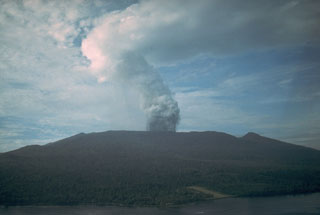Report on Karkar (Papua New Guinea) — October 1994
Bulletin of the Global Volcanism Network, vol. 19, no. 10 (October 1994)
Managing Editor: Richard Wunderman.
Karkar (Papua New Guinea) Second seismic swarm of 1994
Please cite this report as:
Global Volcanism Program, 1994. Report on Karkar (Papua New Guinea) (Wunderman, R., ed.). Bulletin of the Global Volcanism Network, 19:10. Smithsonian Institution. https://doi.org/10.5479/si.GVP.BGVN199410-251030
Karkar
Papua New Guinea
4.647°S, 145.976°E; summit elev. 1839 m
All times are local (unless otherwise noted)
"A minor seismic unrest occurred on the morning of 18 October, the second one this year, after 15 years of dormancy at this caldera. The local seismograph recorded a large number of low-frequency events starting at about 0200 on 18 October. Events occurred at a rate of up to 2-4/minute. The activity waned after 0930. Although of short duration, this swarm of events was similar to the unrest recorded between 17 May and mid-June 1994, when the long-term deflation of the caldera floor was interrupted."
Geological Summary. Karkar is a 19 x 25 km forest-covered island that is truncated by two nested summit calderas. The 5.5 km outer caldera was formed during one or more eruptions, the last of which occurred 9,000 years ago. The steep-walled 300-m-deep, 3.2 km diameter, inner caldera was formed sometime between 1,500 and 800 years ago. Cones are present on the N and S flanks of this basaltic-to-andesitic volcano; a linear array of small cones extends from the northern rim of the outer caldera nearly to the coast. Recorded eruptions date back to 1643 from Bagiai, a pyroclastic cone constructed within the inner caldera, the floor of which is covered by young, mostly unvegetated andesitic lava flows.
Information Contacts: C. McKee and P. de Saint-Ours, RVO.

